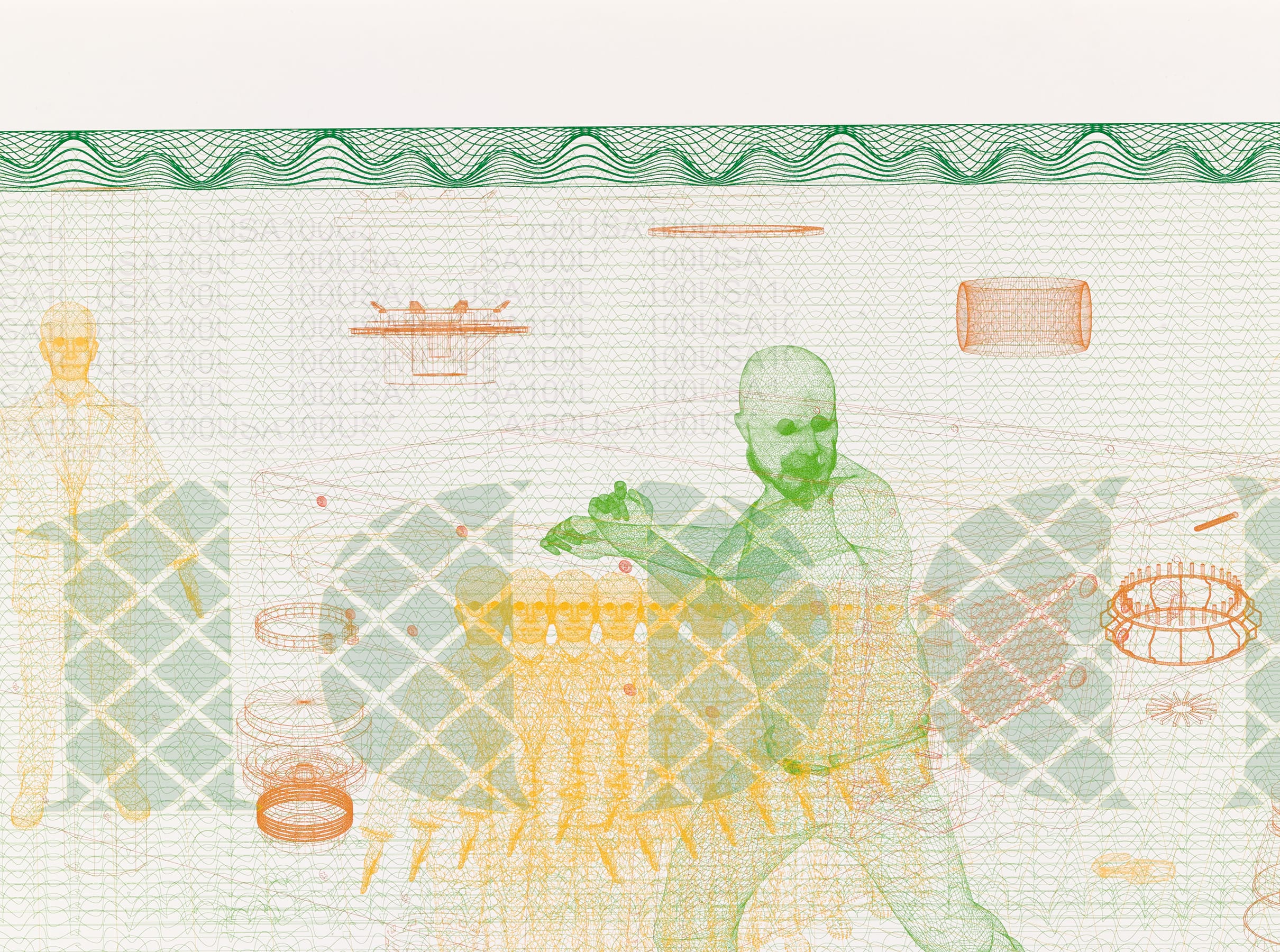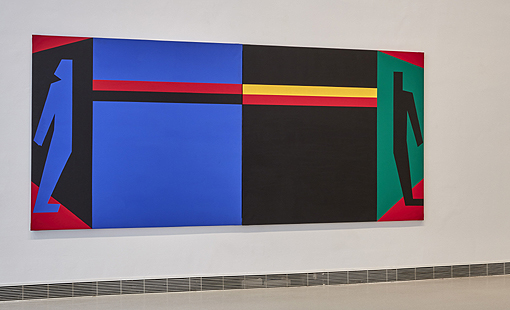
New loans from the Collection for exhibitions in Cordoba, Donostia-San Sebastián, Santiago de Compostela, Valencia and Madrid
In all, eleven works from the Banco de España Collection can currently be seen in five exhibitions at different art venues and museums around Spain: the Museo Nacional Centro de Arte Reina Sofía (MNCARS)![]() in Madrid; the Valencia Institute of Modern Art (IVAM)
in Madrid; the Valencia Institute of Modern Art (IVAM)![]() in Valencia; the Gaias Centre Museum. City of Culture
in Valencia; the Gaias Centre Museum. City of Culture![]() in Santiago de Compostela; the San Telmo Museum
in Santiago de Compostela; the San Telmo Museum![]() in Donostia-San Sebastián and the Andalusian Centre for Contemporary Creation (C3A
in Donostia-San Sebastián and the Andalusian Centre for Contemporary Creation (C3A![]() ) in Cordoba. The Bank is thus maintaining its commitment to open up its collection to society. That commitment has recently led it to set up a programme of temporary exhibitions at its Madrid headquarters on Plaza Cibeles (the latest of which was Flowers and Fruit, which closed on 26 February last) and to create this website, where users can find detailed information on much of the artistic heritage) conserved by the Bank.
) in Cordoba. The Bank is thus maintaining its commitment to open up its collection to society. That commitment has recently led it to set up a programme of temporary exhibitions at its Madrid headquarters on Plaza Cibeles (the latest of which was Flowers and Fruit, which closed on 26 February last) and to create this website, where users can find detailed information on much of the artistic heritage) conserved by the Bank.
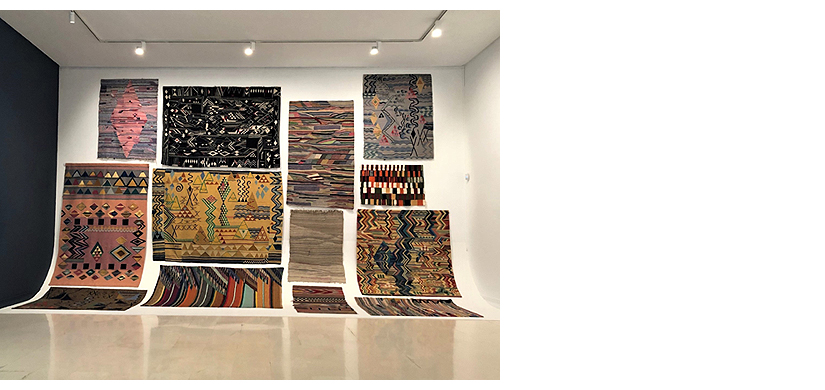 View of the exhibition Teresa Lanceta. Weaving as Open Source. IVAM (Valencia Institute of Modern Art)
View of the exhibition Teresa Lanceta. Weaving as Open Source. IVAM (Valencia Institute of Modern Art)
One of these loans was mentioned in a previous release when we looked at the works from the Collection on show at exhibitions at various museums around Spain in the second half of 2022. The work in question was Untitled (1999), which forms part of the Weaving as Open Source![]() exhibition, focusing on the career of Teresa Lanceta from the 1970s to the present day. After showing
exhibition, focusing on the career of Teresa Lanceta from the 1970s to the present day. After showing![]() at the Barcelona Museum of Contemporary Art (MACBA), it can now be seen at the Valencia Institute of Modern Art (IVAM). This mid-career work is typical of the style of Barcelona-born Lanceta, who sees the act of weaving as a critical activation of the imagination, an ‘open source code’ that is continually being reformulated, 'from which we can read, transform and transmit complex, plural knowledge'.
at the Barcelona Museum of Contemporary Art (MACBA), it can now be seen at the Valencia Institute of Modern Art (IVAM). This mid-career work is typical of the style of Barcelona-born Lanceta, who sees the act of weaving as a critical activation of the imagination, an ‘open source code’ that is continually being reformulated, 'from which we can read, transform and transmit complex, plural knowledge'.
![Vistas de sala de la exposición Camiños Creativos con obras de Eliseo Meifrén Roig y Santiago Rusiñol [foto 1] y Richard Long [foto 2]. Museo Centro Gaiás. Cidade da Cultura](/f/webca/ADS/Noticias/Prest1Semestre2023txt02.jpg) Views of the exhibition Creative Paths featuring works by Eliseo Meifrén Roig and Santiago Rusiñol [Photo 1] and Richard Long [Photo 2]. Gaiás Centre Museum. Cidade de Cultura [City of Culture]
Views of the exhibition Creative Paths featuring works by Eliseo Meifrén Roig and Santiago Rusiñol [Photo 1] and Richard Long [Photo 2]. Gaiás Centre Museum. Cidade de Cultura [City of Culture]
The exhibition is the largest show of Lanceta’s work put together to date. It closes on 16 April next. April 9 marks the closure of Creative Paths![]() , the major exhibition that closes the programme of cultural events for the 2021-2022 'Jacobean Year'. Through over a hundred works from very different periods and in very different styles, this exhibition explores the link between movement and art, highlighting the fact that walking is often a determinant factor in the creative process. It features five works from our Collection, spanning more than a century. The most recent is Being in the Moment (4 Parts) (1999), a series of photos by British artist Richard Long, who has always seen walking as a raw material for his work. The oldest is the oil-painting Gerona Landscape (c. 1884), in which the free-flowing brush-strokes of Catalan painter Santiago Rusiñol portray a humble country lane under a stormy sky. Two more of the works that we loaned to the exhibition date from very close to the time when Rusiñol produced his canvas: Landscape in Asturias (1896), by Madrid-born artist Manuel Ramos Artal and Lake Landscape (1900-1905) by Eliseo Meifrén Roig from Barcelona. This last artist, considered as one of the introducers of the impressionist style in Catalonia, also painted the final work from our Collection included in the exhibition: Houses on the Beach (c. 1940), which demonstrates Meifrén Roig's mastery of au plein air painting. It depicts a small coastal village bathed in the light of the Mediterranean.
, the major exhibition that closes the programme of cultural events for the 2021-2022 'Jacobean Year'. Through over a hundred works from very different periods and in very different styles, this exhibition explores the link between movement and art, highlighting the fact that walking is often a determinant factor in the creative process. It features five works from our Collection, spanning more than a century. The most recent is Being in the Moment (4 Parts) (1999), a series of photos by British artist Richard Long, who has always seen walking as a raw material for his work. The oldest is the oil-painting Gerona Landscape (c. 1884), in which the free-flowing brush-strokes of Catalan painter Santiago Rusiñol portray a humble country lane under a stormy sky. Two more of the works that we loaned to the exhibition date from very close to the time when Rusiñol produced his canvas: Landscape in Asturias (1896), by Madrid-born artist Manuel Ramos Artal and Lake Landscape (1900-1905) by Eliseo Meifrén Roig from Barcelona. This last artist, considered as one of the introducers of the impressionist style in Catalonia, also painted the final work from our Collection included in the exhibition: Houses on the Beach (c. 1940), which demonstrates Meifrén Roig's mastery of au plein air painting. It depicts a small coastal village bathed in the light of the Mediterranean.
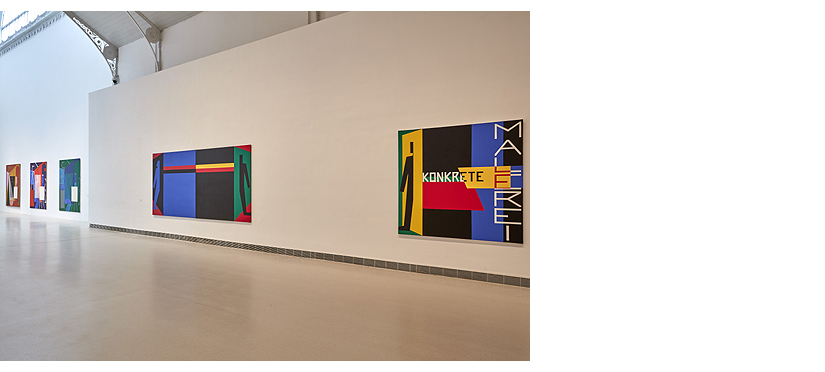 View of the exhibition Manolo Quejido. Immeasurable Distance. Museo Nacional Centro de Arte Reina Sofía (MNCARS)
View of the exhibition Manolo Quejido. Immeasurable Distance. Museo Nacional Centro de Arte Reina Sofía (MNCARS)
Immeasurable Distance![]() , the retrospective organised by the Reina Sofía on Seville-born artist Manolo Quejido, includes the diptych Conexión V-Q (2003), one of the works by him held in our Collection. This large work (measuring 180 x 389 cm) is from a later period in his long career, marked by a continual process of exploration of the links between painting and thought. From the very title, it is obvious that painter Diego de Velázquez (also from Seville) was a major influence on his work, which features a sort of variation or evolution of exercises exploring the parameters that delimit an indoor scene which Quejido develops in key series throughout his career such as Reflections and Partition Walls. That variation leads him to explore and champion (here and in other works such as those of the Moebius series) the possibility of a painting’s being pure surface, making it explicitly two-dimensional and removing all impressions of thickness and illusions of volume.
, the retrospective organised by the Reina Sofía on Seville-born artist Manolo Quejido, includes the diptych Conexión V-Q (2003), one of the works by him held in our Collection. This large work (measuring 180 x 389 cm) is from a later period in his long career, marked by a continual process of exploration of the links between painting and thought. From the very title, it is obvious that painter Diego de Velázquez (also from Seville) was a major influence on his work, which features a sort of variation or evolution of exercises exploring the parameters that delimit an indoor scene which Quejido develops in key series throughout his career such as Reflections and Partition Walls. That variation leads him to explore and champion (here and in other works such as those of the Moebius series) the possibility of a painting’s being pure surface, making it explicitly two-dimensional and removing all impressions of thickness and illusions of volume.
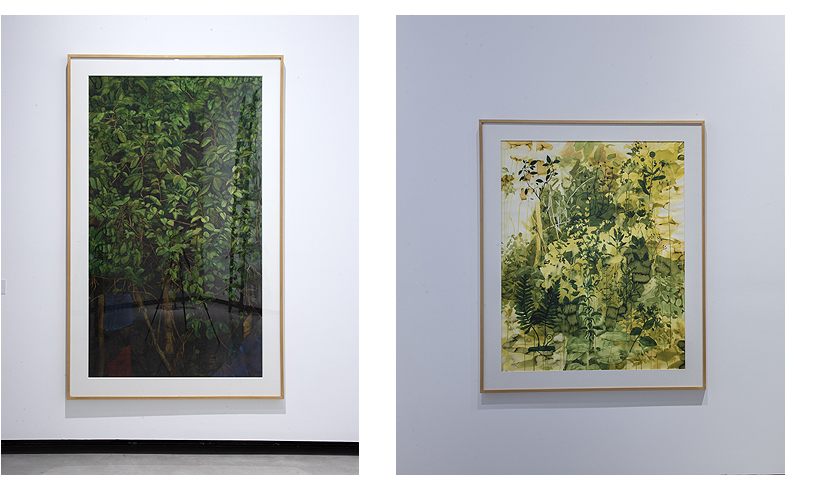 The works Yagé (2000) and Medicinal Garden (2001) at the Sombra verde [‘Green Shadow’] exhibition Federico Guzmán y la carrera de las plantas ['Green Shade: Federico Guzmán and the Way of Plants'] at the C3A (Andalusian Centre for Contemporary Creation)
The works Yagé (2000) and Medicinal Garden (2001) at the Sombra verde [‘Green Shadow’] exhibition Federico Guzmán y la carrera de las plantas ['Green Shade: Federico Guzmán and the Way of Plants'] at the C3A (Andalusian Centre for Contemporary Creation)
Another Seville-born artist, Federico Guzmán, painted two other works from the Banco de España Collection loaned out in the first half of 2023: the watercolours Yagé (2000) and Medicinal Garden (2001). Both can be seen in the exhibition Green Shade. Federico Guzmán and the Way of Plants![]() , which opened at the Andalusian Centre for Contemporary Creation (C3A) on 30 March and brings together a broad selection of works from the last 20 years of Guzman's career. These are works in which plants form a leitmotiv and where environmental critiques and the assumption of a post-colonial discourse play a core role. The two works on loan are cases in point. They also highlight the importance of the time the artist spent in the Western Sahara and Colombia in the changes in his work over the course of his career. Both pictures are strikingly vitalist (as indeed is his output as a whole). In them, Guzmán evidences his conviction that we need to regain a direct relationship with nature and argues for the healing power (in the broadest sense) of certain ancestral rituals associated with it.
, which opened at the Andalusian Centre for Contemporary Creation (C3A) on 30 March and brings together a broad selection of works from the last 20 years of Guzman's career. These are works in which plants form a leitmotiv and where environmental critiques and the assumption of a post-colonial discourse play a core role. The two works on loan are cases in point. They also highlight the importance of the time the artist spent in the Western Sahara and Colombia in the changes in his work over the course of his career. Both pictures are strikingly vitalist (as indeed is his output as a whole). In them, Guzmán evidences his conviction that we need to regain a direct relationship with nature and argues for the healing power (in the broadest sense) of certain ancestral rituals associated with it.
 The works Hug and Fight II (Eulàlia Valldosera, 1997) and Odessa (Rogelio López Cuenca, 1992) at the Los nuevos 90 ['The New 90s'] exhibition. San Telmo Museum
The works Hug and Fight II (Eulàlia Valldosera, 1997) and Odessa (Rogelio López Cuenca, 1992) at the Los nuevos 90 ['The New 90s'] exhibition. San Telmo Museum
The other exhibition currently open to the public that features works from our Collection is The New 90s![]() , which opened at the San Telmo Museum on 4 March. Through a selection of works by 146 individual artists and collectives who made their names between the late 1980s and the turn of the century, with the specific setting of the Basque Country as a starting point, this exhibition looks at the cultural ecosystem that emerged in that transitional period, marked by changes in economic models and the switch from analogue to digital. The Banco de España Collection's contribution to the exhibition comprises works by two artists —Eulàlia Valldosera and Rogelio López Cuenca— who produced works in multiple disciplines during the period in question, with a definite tone of criticism. Eulàlia Valldosera produces works that deconstruct female stereotypes and, assuming the feminist contention that the personal is political, addresses issues such as motherhood, the construction of identities, desire and how dynamics of control and social oppression are reproduced in private and domestic settings. A good example is Hug and Fight II (1997), the work on loan to the exhibition. It is a photo diptych in which, in the words of Beatriz Herráez, the artist creates one of her ‘blurred, disturbing scenes alluding to the invisible violence that runs through everyday life’.
, which opened at the San Telmo Museum on 4 March. Through a selection of works by 146 individual artists and collectives who made their names between the late 1980s and the turn of the century, with the specific setting of the Basque Country as a starting point, this exhibition looks at the cultural ecosystem that emerged in that transitional period, marked by changes in economic models and the switch from analogue to digital. The Banco de España Collection's contribution to the exhibition comprises works by two artists —Eulàlia Valldosera and Rogelio López Cuenca— who produced works in multiple disciplines during the period in question, with a definite tone of criticism. Eulàlia Valldosera produces works that deconstruct female stereotypes and, assuming the feminist contention that the personal is political, addresses issues such as motherhood, the construction of identities, desire and how dynamics of control and social oppression are reproduced in private and domestic settings. A good example is Hug and Fight II (1997), the work on loan to the exhibition. It is a photo diptych in which, in the words of Beatriz Herráez, the artist creates one of her ‘blurred, disturbing scenes alluding to the invisible violence that runs through everyday life’.
Violence, be it real or symbolic, as a tool for social control and the misuse of images by those in power to legitimise and perpetuate it are core features of the work of Rogelio López Cuenca. Last year this Malaga-born artist was awarded the National Award for Plastic Arts (won by Valldosera in 2002). The work by him on loan here is Odessa (1992), a small collage linked to a group of works in which he appropriates the designs created to identify Expo '92. Here, he superimposes a number of replicas of the armillary sphere that served as the logo of the Expo on a frame from the famous scene in the film Battleship Potemkin (Sergei M. Eisenstein, 1925) that depicts the massacre of civilians on the steps of the city of Odessa by the Tsarist White Army. López Cuenca shows these spheres as rolling projectiles aiding the soldiers in their indiscriminate charge against the demonstrators, so that, in the words of Carlos Martín, the logo becomes a sort of ‘icon of capitalism triumphant’ that wipes out the last symbolic vestiges of the Soviet revolutionary utopia (this work was produced shortly after the fall of the Berlin Wall, at a time when there was much talk of ‘the end of history’).
